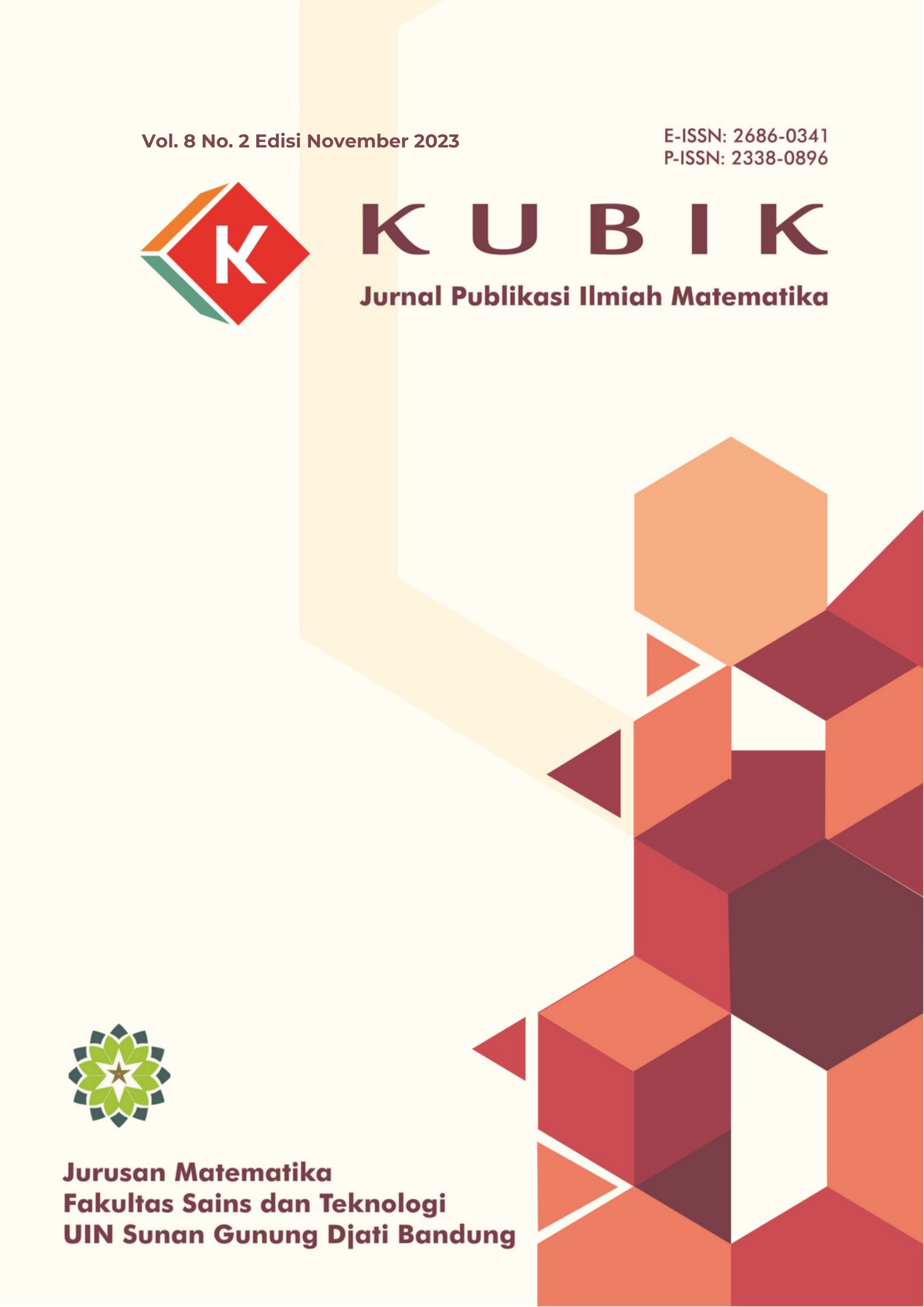Ekstraksi Topik Pantun di Twitter Menggunakan K-Means Clustering
DOI:
https://doi.org/10.15575/kubik.v8i1.29191Keywords:
pantun, topic analysis, K-Means clusteringAbstract
Pantun is an old form of poetry in Indonesia. Over time, the anxiety of the existence of rhymes in society has become the anxiety of literary, language and cultural activists. This study aims to explore the existence of the use of rhymes on social media which was highly encouraged by young people in the era of Society 5.0. There are two types of rhymes studied, namely general and islamic rhymes. The method used is K-Means clustering analysis to find rhyme topics that are often used in social media. The general category of pantun cluster structure belongs to the weak structure because the silhouette coefficient values are in the range of 0.26-0.5 while the Islamic pantun group structure belongs to the good too strong structure because the silhouette coefficient values are in the range of 0.4-0.9. It was found that the general category of rhymes were still widely used on social media with the type of theme being youth rhymes. The purpose of using the rhyme is more dominant to express feelings. On the other hand, the islamic category of rhymes is rarely used on social media with the type of theme being parental rhymes. The purpose of using the rhyme is more dominant to religious symbols.
References
D. E. Maulina, “Keanekaragaman Pantun,†Semantik, vol. 1 No 1, no. 1, pp. 107–121, 2012, [Online]. Available: http://e-journal.stkipsiliwangi.ac.id/index.php/semantik/article/view/103
M. S. Mahayana, “Pantun Sebagai Potret Sosial Budaya Tempatan Perbandingan Pantun Melayu, Jawa, Madura, Dan Betawi,†Jurnal Kritik, vol. 4, pp. 85–100, 2013.
A. Aslan and A. Yunaldi, “Budaya Berbalas Pantun Sebagai Media Penyampaian Pesan Perkawinan Dalam Acara Adat Istiadat Perkawinan Melayu Sambas,†Transformatif, vol. 2, no. 2, pp. 111–122, 2019, doi: 10.23971/tf.v2i2.962.
A. Yuliansyah, “Struktur Dan Fungsi Pantun Dalam Upacara Adat Perkawinan Melayu Tanjung Hulu Kecamatan Pontianak Timur,†Jurnal Pendidikan Bahasa, vol. 8, no. 2, p. 281, 2019, doi: 10.31571/bahasa.v8i2.1432.
K. Pantun, R. dan Leluhur Bangsa Dulu, and K. dan Selamanya SITI HAJAR CHE MAN ABSTRAK, “Siti Hajar Che Man 75,†International Journal of the Malay World and Civilisation (Iman), vol. 1, no. 1, p. 2013.
J. E. Gentle, L. Kaufman, and P. J. Rousseuw, Finding Groups in Data: An Introduction to Cluster Analysis., vol. 47, no. 2. New Jersey: Wiley-Interscience, 1991. doi: 10.2307/2532178.
B. W. Arianto and G. Anuraga, “Topic Modeling for Twitter Users Regarding the ‘Ruanggguru’ Application,†Jurnal ILMU DASAR, 2020. https://jurnal.unej.ac.id/index.php/JID/article/view/17112/8412 (accessed Dec. 06, 2021).
Christhoper Nugraha, “Pendeteksian topik pada twitter menggunakan online eigenspace-based fuzzy c-means clustering untuk big data = Topic detection on twitter using online eigenspace-based fuzzy c-means clustering for big data / Christhoper Nugraha.†2019. Accessed: Dec. 06, 2021. [Online]. Available: http://lontar.ui.ac.id
H. Februariyanti, J. S. Wibowo, D. B. Santoso, and M. Sukur, “Analisis Kecenderungan Informasi Menggunakan Algoritma Hierarchical Agglomerative Clustering,†I N F O R M a T I K a, vol. 13, no. 1, p. 9, Jun. 2021, doi: 10.36723/juri.v13i1.247.
B. A. Dwiarni and B. Setiyono, “Akuisisi dan Clustering Data Sosial Media Menggunakan Algoritma K-Means sebagai Dasar untuk Mengetahui Profil Pengguna,†Jurnal Sains dan Seni, vol. 8, no. 2, pp. 2337–3520, 2019, [Online]. Available: https://apps.twitter.com/
A. N. Yusril, I. Larasati, and Q. Aini, “Implementasi Text Mining Untuk Advertising Dengan Menggunakan Metode K-Means Clustering Pada Data Tweets Gojek Indonesia,†Sistemasi, vol. 9, no. 3, p. 586, Sep. 2020, doi: 10.32520/stmsi.v9i3.924.
P. Kurniawan, E. Utami, and A. Sunyoto, “Perbandingan Teknik Pengklasteran Dalam Visualisasi Data Teks Bahasa Indonesia,†2017.
C. Yuan and H. Yang, “Research on K-Value Selection Method of K-Means Clustering Algorithm,†J (Basel), vol. 2, no. 2, pp. 226–235, 2019, doi: 10.3390/j2020016.
O. R. Battaglia, B. di Paola, and C. Fazio, “K-means clustering to study how student reasoning lines can be modified by a learning activity based on Feynman’s unifying approach,†Eurasia Journal of Mathematics, Science and Technology Education, vol. 13, no. 6, pp. 2005–2038, 2017, doi: 10.12973/eurasia.2017.01211a.
S. Nanjundan, S. Sankaran, C. R. Arjun, and G. P. Anand, “Identifying the number of clusters for K-Means: A hypersphere density based approach,†2019. [Online]. Available: http://arxiv.org/abs/1912.00643
N. Ulinnuha and S. A. Sholihah, “Analisis Cluster untuk Pemetaan Data Kasus Covid-19 di Indonesia Menggunakan K-Means,†Jurnal MSA(Matematika dan Statistika serta Aplikasinya), vol. 9, no. 2, pp. 27–31, 2021.
E. Syafaqoh, dkk, “Klusterisasi Penyandang Masalah Kesejahteraan Sosial (PMKS) Di Kabupaten Bojonegoro Menggunakan Algoritma K-Medoids,†KUBIK: Jurnal Publikasi Ilmiah Matematika, vol. 7, no. 2, pp. 78-87, 2022, doi: 10.15575/kubik.v7i2.21653.
I. Nurandini and A.F. Huda, “Klastering Dokumen dengan Menambahkan Metadata Menggunakan Algoritma COATES,†KUBIK: Jurnal Publikasi Ilmiah Matematika, vol. 2, no. 2, pp. 39-44, 2017, doi: 10.15575/kubik.v2i2.1859.
Downloads
Published
How to Cite
Issue
Section
Citation Check
License
Authors who publish in KUBIK: Jurnal Publikasi Ilmiah Matematika agree to the following terms:
- Authors retain copyright and grant the journal right of first publication with the work simultaneously licensed under a Attribution-ShareAlike 4.0 International (CC BY-SA 4.0) License that allows others to share the work with an acknowledgment of the work's authorship and initial publication in this journal.
- Authors are able to enter into separate, additional contractual arrangements for the non-exclusive distribution of the journal's published version of the work (e.g., post it to an institutional repository or publish it in a book), with an acknowledgment of its initial publication in this journal.
- Authors are permitted and encouraged to post their work online (e.g., in institutional repositories or on their website) prior to and during the submission process, as it can lead to productive exchanges, as well as earlier and greater citation of published work (See The Effect of Open Access).
Â









